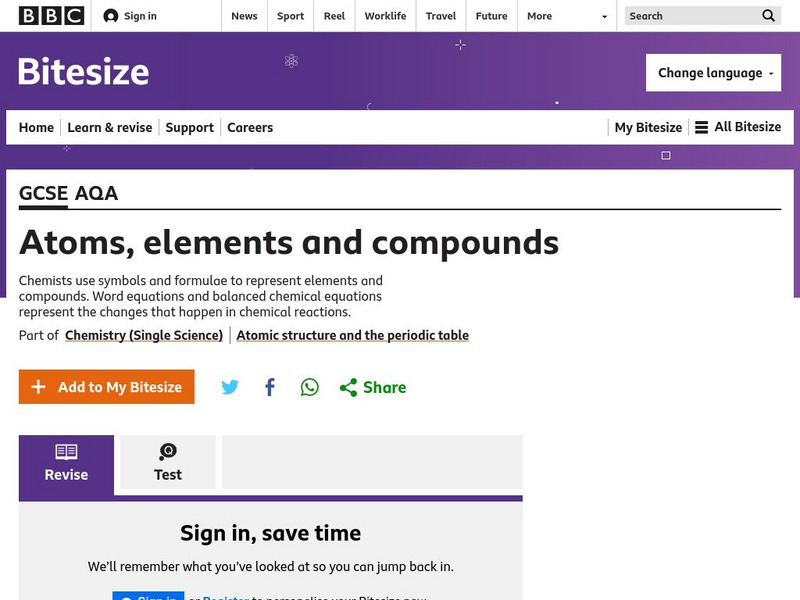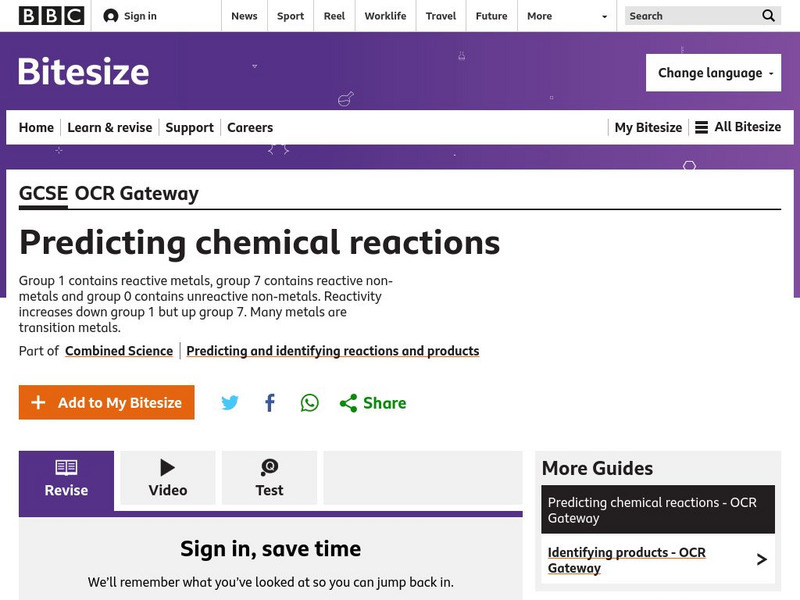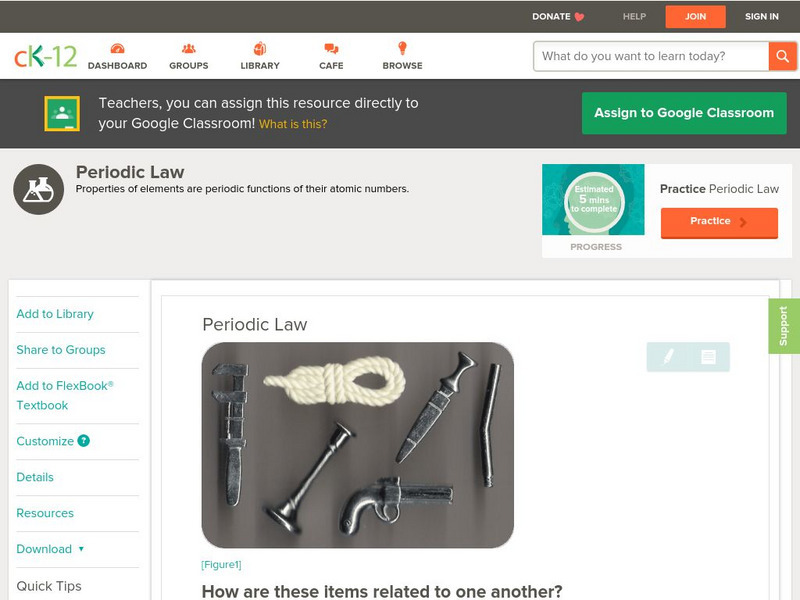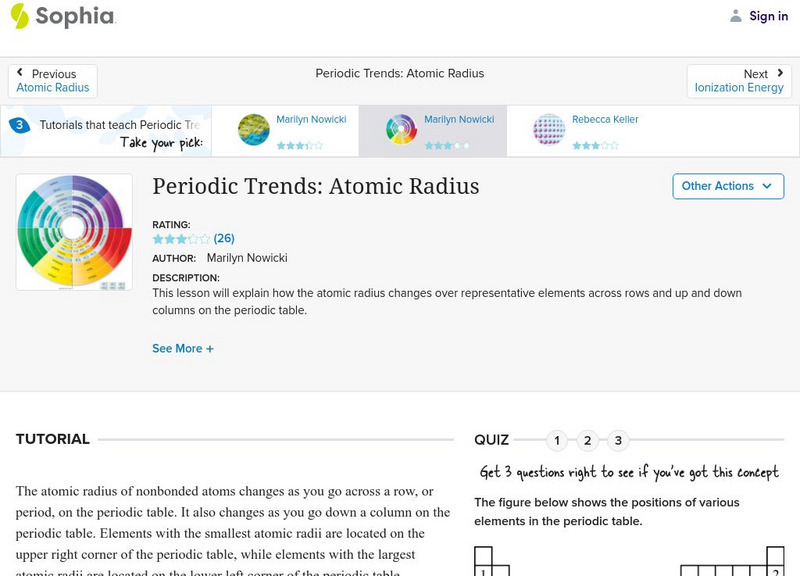BBC
Bbc: Gcse Bitesize Science: Atomic Structure
An explanation of atomic structure and the element groups in the periodic table using plain language. Supported by diagrams and charts.
BBC
Bbc: Gcse Bitesize: Atoms, Elements and Compounds
This lesson focuses on atoms and elements including what they are, the chemical symbols for elements, and the placement of elements on the periodic table. A link to a test is provided.
Web Elements
Web Elements Periodic Table: Sodium
All of the elemental information that you are likely to need can be found at this extensive site, including; atomic number, atomic weight, group name, standard state, properties, uses, electron configuration, typical compounds and much...
Web Elements
Web Elements Periodic Table: Samarium
All of the elemental information that you are likely to need can be found at this extensive site, including atomic number, atomic weight, group name, standard state, properties, uses, electron configuration, typical compounds and much...
Science Struck
Science Struck: Periodic Table With Atomic Mass
Explains how Dmitri Mendeleev created the periodic table of elements, how it was organized, the changes made by Henry Moseley in 1931, some characteristics of element groups, and what the atomic mass, number, and abbreviation each...
Science4Fun
Science4 Fun: Periodic Table
What is the periodic table? Learn how the elements are classified according to their properties and are organized into groups and periods.
Sophia Learning
Sophia: Periodic Table: Lesson 2
Explain how elements on the periodic table are arranged, and explain the relationships within each row and column. This lesson is 2 of 4 in the series titled "Periodic Table."
Chem4kids
Chem4 Kids: Families Stick Together
Beyond columns and rows, the periodic table groups elements according to families. Identify the families present on the table with this overview.
BBC
Bbc: Gcse Bitesize: Predicting Chemical Reactions
This lesson focuses on predicting chemical reactions using The Group 1 elements in the Periodic Table are known as the alkali metals. They include lithium, sodium and potassium, which all react vigorously with air and water. It provides...
Sophia Learning
Sophia: Metallic Character: Lesson 3
This lesson will describe metallic character and describe how it changes throughout the periodic table. It is 3 of 3 in the series titled "Metallic Character."
Annenberg Foundation
Annenberg Learner: What's in the Box?
Use your knowledge of groups and periods on the Periodic Table. When you are presented with three elements, pick the one that doesn't belong.
Chem Tutor
Chem Tutor: Atomic Structure: Atomic Weights and Atomic Numbers
This lesson explains many basic concepts of atomic structure. It starts with atomic mass and number and then works up to more sophisticated information on electron configuration and how each element fits into the Periodic Table.
CK-12 Foundation
Ck 12: Chemistry: Periodic Law
[Free Registration/Login may be required to access all resource tools.] A tutorial that describes the origin of the periodic law.
Upper Canada District School Board
Tom Stretton's Chemistry Pages: The Noble Gases
Through an online slideshow format, learn about the chemical properties and practical uses of the noble gases. Includes questions at end.
Chem4kids
Chem4 Kids: The Noble Gases
Get the skinny on the noble gases on the periodic table. Find out why this family is happy, how well they bond, and exactly who is a part of this happy family.
Chem4kids
Chem4 Kids: Heading to Group Two
The second family in the periodic table is the alkaline earth metals found in the second column from the left. Meet the family and get to familiar with why this is the second most reactive group of elements.
Chem4kids
Chem4 Kids: Alkali Metals to the Left
To the left. To the left. The elements in the left column of the period table are alkali metals with the exception of hydrogen. This is a brief overview of the alkali metals, what their family is all about and how well they bond or do...
Science Education Resource Center at Carleton College
Serc: Group and Periodic Properties Lab
Students observe and perform experiments with sodium, potassium, calcium, magnesium, sulfur ,and phosphorus. The discover trends down groups, across periods, and having to do with the pH of metal oxides vs. nonmetal oxides.
Web Elements
Web Elements Periodic Table: Scandium
All of the elemental information about scandium that you are likely to need can be found at this extensive site. This information includes atomic number, atomic weight, group name, standard state, properties, uses, electron...
Web Elements
Web Elements Periodic Table: Sulfur
All of the elemental information about sulfur that you are likely to need can be found at this extensive site. This information includes atomic number, atomic weight, group name, standard state, properties, uses, electron configuration,...
Science Struck
Science Struck: Inner Transition Metals
Discusses the organization of the periodic table into periods and groups, then looks at where the Lanthanoids and Actinoids are situated, and their properties.
Science Struck
Science Struck: Printable Periodic Table of Elements With Names
Provides two printable periodic tables, color-coded to show the element groups. One table gives masses, the other gives charges.
Clackamas Community College
Clackamas Community College: Chemical Groups
This site, which is provided for by the Clackamas Community College, gives a basic explanation of Chemical Grouping, including the Boron group.
Sophia Learning
Sophia: Periodic Trends: Atomic Radius: Lesson 3
This lesson will explain how the atomic radius changes over representative elements across rows and up and down columns on the periodic table. It is 3 of 3 in the series titled "Periodic Trends: Atomic Radius."

















